Now a tropical storm with winds of 50 mph, Michael is expected to gain strength as it passes into Virginia and moves into the western Atlantic Ocean overnight, bringing damaging winds and life-threatening flash flooding over parts of North Carolina and Virginia.Six people are dead in the storm's path, and authorities fear the toll could climb higher as search-and-rescue efforts continue. So far, Coast Guard crews in Florida have rescued 40 people and assisted 232.Conditions remain precarious in hard hit areas, especially Mexico Beach, Florida, where Michael reduced buildings to rubble and snapped trees in half. A councilwoman from there issued an urgent plea to anyone thinking of returning. "Please don't come down," Linda Albrecht said. "The more people that return, it's just going to get in the way."Track the storm
Key developments
• Where is Michael? As of Thursday evening, the storm was centered about five miles northwest of Roanoke Rapids, North Carolina with maximum sustained winds of 50 mph.• Power outages are on the rise: 1.3 million customers in six states are without power, including 604,831 in North Carolina.• Victims identified: The dead include four people in Florida, a child in Georgia and a man in North Carolina.• Public health emergency declared in Georgia: The declaration will help ensure those who rely on Medicare and Medicaid have access to the care they need, Health and Human Services Secretary Alex Azar said.
'Our lives are gone here'
Catastrophic scenes have emerged across the Florida Panhandle, but none perhaps worse than in Mexico Beach, ground zero of the devastation. Receding floodwater are just starting to reveal the extent of damage. What used to be a gorgeous beachfront city now looks like an apocalyptic mess. "First the cars started floating by, and all the debris was in the air," Mexico Beach resident Scott Boutwell said. "When the water came in, houses started floating in front of our home." 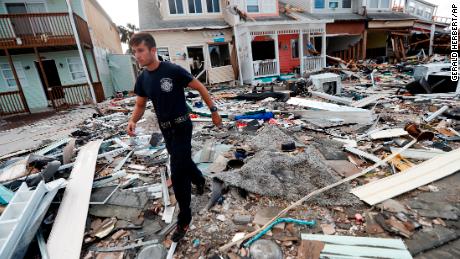 When Boutwell returned to his own house, he discovered furniture in his house that wasn't his. The walls had collapsed and "the only thing I could find of ours was my briefcase," he said.As he looked around, a new reality set in: "Our lives are gone here. All the stores, all the restaurants, everything. There's nothing left here anymore." Albrecht, the Mexico Beach councilwoman, would like to return home, but she says the roads are impassible. She's desperate for news about the condition of her home, but she can't reach anyone, she says.She chokes up talking about it. "I just need to know."
When Boutwell returned to his own house, he discovered furniture in his house that wasn't his. The walls had collapsed and "the only thing I could find of ours was my briefcase," he said.As he looked around, a new reality set in: "Our lives are gone here. All the stores, all the restaurants, everything. There's nothing left here anymore." Albrecht, the Mexico Beach councilwoman, would like to return home, but she says the roads are impassible. She's desperate for news about the condition of her home, but she can't reach anyone, she says.She chokes up talking about it. "I just need to know."
School that helped Hurricane Maria victims is now destroyed
The students and staff at Jinks Middle School have dealt with disaster before. Last year, they welcomed children who were displaced by Hurricane Maria in Puerto Rico. This time, the Panama City school was ripped apart by Michael. The debris-covered floor of the school's gymnasium is now fully visible from outside. Principal Britt Smith choked up as he looked at images of the decimated building. "You can't make sense of it, but what you do is you take the situation, and what we have to make certain that our kids know is that we must be resilient," Smith said. "Resiliency is important, and it's an important life message that we all have to learn. … But at this point, there's really no making sense. It's just how do we get together, how do we recover?"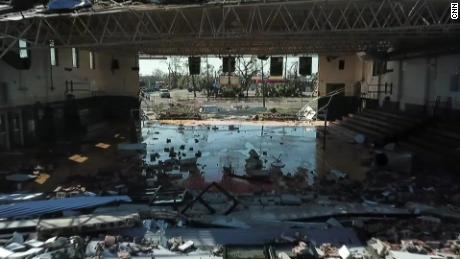
'I just need to know he's OK'
Uprooted trees, downed power poles and limited communications have made it hard for first responders and families to reach residents in need. 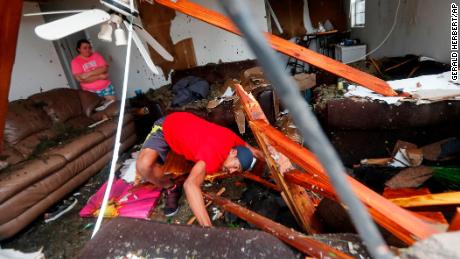 In Seminole County, Georgia, a metal carport crashed through a roof, hitting a girl's head. Several hours passed before emergency officials could reach the unincorporated area where the girl was killed, county emergency management director Travis Brooks said. The county coroner identified the girl as 11-year-old Sarah Radney. "She loved God, she was Christian. When the doors to the church were open she would want to be there," her father Roy Radney said. When her parents couldn't make it to church, Sarah would get up early and call her aunt for a ride, he said.One of the four victims from Florida has been identified as Steven Sweet, the Gadsden County sheriff's office said. Sweet died after a tree fell on a home near Greensboro. Megan McCall says her brother Jeff and his family were riding out the storm in the Panhandle. No one has heard from them since Wednesday afternoon.Her brother was able to tell a friend that his home was starting to get cracks in the walls and water was rushing in Wednesday. A neighbor told McCall that all the docks in the area were destroyed and many people are stuck in their homes as the roads have been blocked with debris."I just need to know he's OK," McCall said. "If the house and the cars are destroyed they can be replaced, but my niece needs her dad — and as much as I sometimes can't stand him, I would do anything to just know he's OK."
In Seminole County, Georgia, a metal carport crashed through a roof, hitting a girl's head. Several hours passed before emergency officials could reach the unincorporated area where the girl was killed, county emergency management director Travis Brooks said. The county coroner identified the girl as 11-year-old Sarah Radney. "She loved God, she was Christian. When the doors to the church were open she would want to be there," her father Roy Radney said. When her parents couldn't make it to church, Sarah would get up early and call her aunt for a ride, he said.One of the four victims from Florida has been identified as Steven Sweet, the Gadsden County sheriff's office said. Sweet died after a tree fell on a home near Greensboro. Megan McCall says her brother Jeff and his family were riding out the storm in the Panhandle. No one has heard from them since Wednesday afternoon.Her brother was able to tell a friend that his home was starting to get cracks in the walls and water was rushing in Wednesday. A neighbor told McCall that all the docks in the area were destroyed and many people are stuck in their homes as the roads have been blocked with debris."I just need to know he's OK," McCall said. "If the house and the cars are destroyed they can be replaced, but my niece needs her dad — and as much as I sometimes can't stand him, I would do anything to just know he's OK."
Growing path of pain
After slamming Florida and lashing Georgia, Michael is now barreling through the storm-weary Carolinas. Tornadoes, dangerous winds and more flooding are possible in many of the same areas still recovering from Hurricane Florence. Michael is expected to dump up to 7 inches of rain in parts of North Carolina and Virginia, the National Hurricane Center said.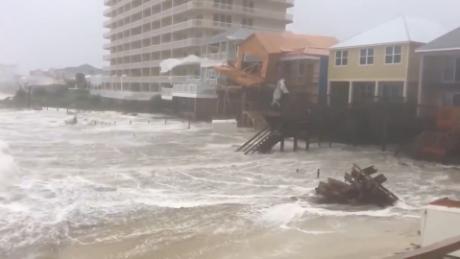 A 38-year old man died when a large tree fell on his vehicle on Highway 64, East of Statesville, North Carolina, Iredell County Fire Marshall David Souther said.In southwestern Virginia, Emily Waddell said the water level in a creek near her property in Simpsons already surpassed what it experienced during Florence. So far, she says she has lost a chicken coop and four of six of gardens due to Michael's fallout."We didn't expect it to get this bad," she told CNN via Instagram.
A 38-year old man died when a large tree fell on his vehicle on Highway 64, East of Statesville, North Carolina, Iredell County Fire Marshall David Souther said.In southwestern Virginia, Emily Waddell said the water level in a creek near her property in Simpsons already surpassed what it experienced during Florence. So far, she says she has lost a chicken coop and four of six of gardens due to Michael's fallout."We didn't expect it to get this bad," she told CNN via Instagram.
The impact of climate change on storms
Michael's strength may reflect the effect of climate change on storms. The planet has warmed significantly over the past several decades, causing changes in the environment.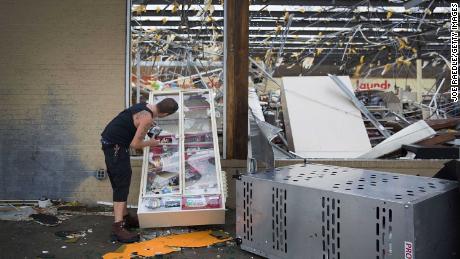 Human-caused greenhouse gases in the atmosphere create an energy imbalance, with more than 90% of remaining heat trapped by the gases going into the oceans, according to the National Oceanographic and Atmospheric Administration. While we might not get more storms in a warmer climate, most studies show storms will get stronger and produce more rain. Storm surge is worse now than it was 100 years ago, thanks to the rise in sea levels.And unless we change the rate of greenhouse gas emissions, we should expect hurricanes to intensify more rapidly in the coming decades, the scientific research group Climate Central said.
Human-caused greenhouse gases in the atmosphere create an energy imbalance, with more than 90% of remaining heat trapped by the gases going into the oceans, according to the National Oceanographic and Atmospheric Administration. While we might not get more storms in a warmer climate, most studies show storms will get stronger and produce more rain. Storm surge is worse now than it was 100 years ago, thanks to the rise in sea levels.And unless we change the rate of greenhouse gas emissions, we should expect hurricanes to intensify more rapidly in the coming decades, the scientific research group Climate Central said.
CNN's Spencer Parlier, Scott McLean, Dave Alsup, Hollie Silverman, Jamiel Lynch, Amanda Watts, AnneClaire Stapleton and Nicole Chavez contributed to this report.
Original Article
[contf] [contfnew] 
CNN
[contfnewc] [contfnewc]






